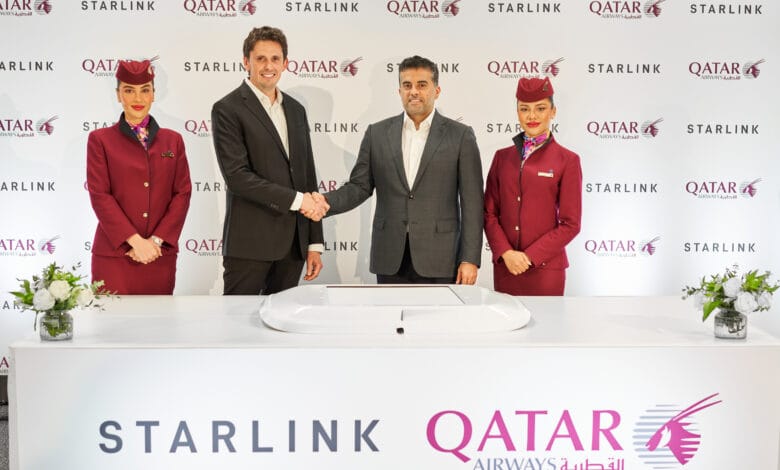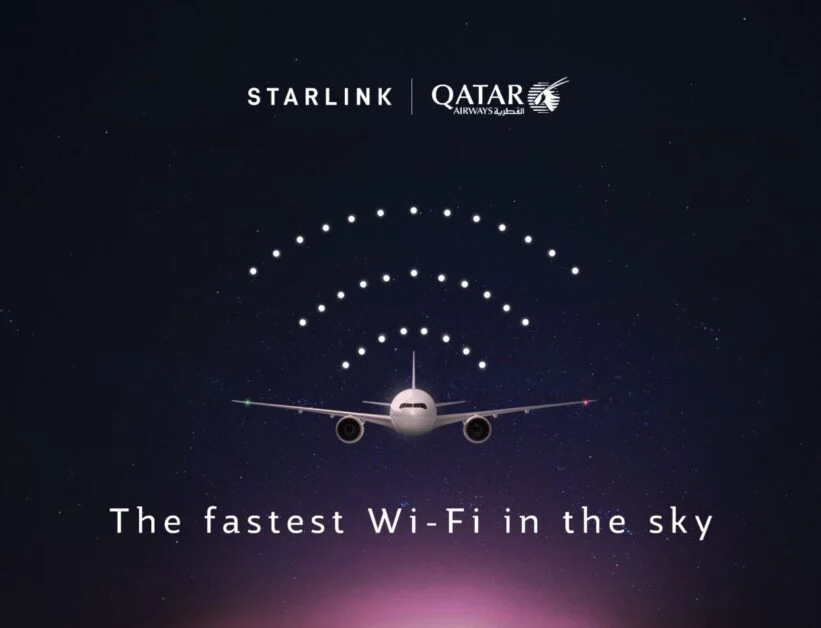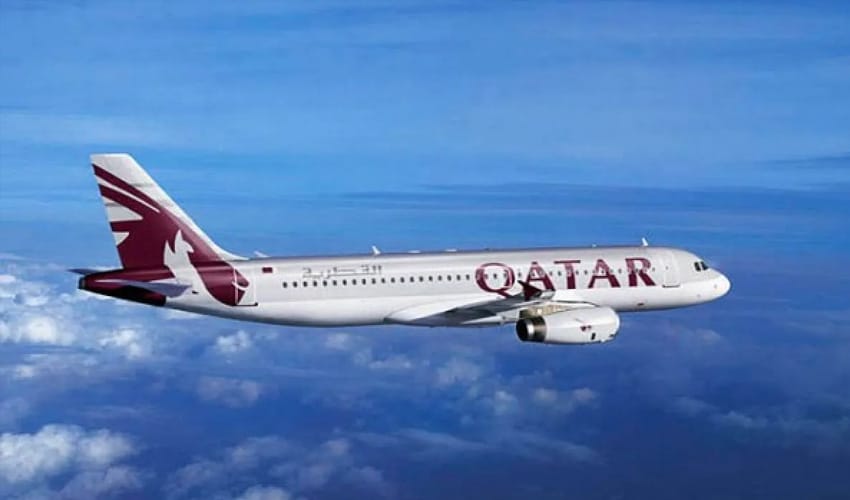World’s First Starlink-Equipped Flight by Qatar Airways: A Game Changer in Air Travel

Qatar Airways recently became the first airline in worldwide to provide Starlink satellite internet access on its commercial flights, in a historic move that aims to revolutionize in-flight connectivity. The airline sector and internet accessibility have advanced significantly with this invention, which sets new benchmarks for travelers’ online experiences.
Passengers on Qatar Airways’ firstStarlink-equipped flight may now experience high-speed internet, which was previously inconceivable at cruising altitudes. This article explores the reasons for this technical advancement, its potential to revolutionize the passenger experience, and its ramifications for air travel in the future.
Table of Contents
Why Qatar Airlines Selected Starlink: Transforming Internet in-flight
A leader in aviation innovation for many years, Qatar Airways is renowned for its opulent service and state-of-the-art equipment. The airline’s partnership with SpaceX’s satellite internet subsidiary, Starlink, was a calculated step to improve the Traveller experience by providing them with previously unheard-of connectivity while in flight.
1. Partnership with Starlink: A Strategic Move
Qatar Airways and Starlink’s partnership is a part of a larger trend in the aviation sector as airlines are looking to collaborate with internet firms to enhance their offerings. Starlink, a spinoff of Elon Musk’s SpaceX, has rapidly constructed a massive constellation of low-Earth orbit (LEO) satellites meant to provide high-speed internet access around the world, including rural and difficult-to-reach locations. Starlink’s large satellite network places it in a unique position to deliver the consistent, worldwide internet connectivity that modern airlines demand to remain competitive.
2. Demand for Better In-Flight Connectivity
In today’s hyperconnected world, having dependable and quick internet has become essential for Travellers, especially digital nomads and business Travellers. Conventional in-flight Wi-Fi networks, which depend on outdated satellite technology or ground-based signals, can offer sluggish, erratic connections, particularly on lengthy flights. With the implementation of Starlink, Qatar Airways hopes to tackle this problem head-on by offering Travellers speeds comparable to those of home broadband connections, facilitating smooth gaming, video streaming, and even online conferences while in flight.
What Does the Starlink Experience Mean for Passengers?
Passengers on Qatar Airways’ Starlink-equipped planes can now enjoy an unrivalled internet experience. The system promises:
- No Connectivity Gaps
Passengers using Starlink may expect uninterrupted internet connectivity from gate to gate, especially on transoceanic flights. Traditional satellite systems frequently have coverage gaps, particularly overseas and polar regions, while Starlink’s global network provides continuous service wherever passengers go.
- Speeds of up to 100 Mbps
Internet speeds will be available to passengers, allowing for hitherto unimaginable activities at 35,000 feet. This covers buffer-free video streaming, uploading big files, and even video conferencing. Long-haul Travellers will benefit most from such high-speed access, which will provide them with an “always connected” experience.
- Low Latency
One of the primary benefits of Starlink’s low-Earth orbit satellite technology is the reason its low latency. Unlike typical geostationary satellites, that orbit far away from planet Earth, Starlink’s satellites circle much closer, lowering the time it takes for information to travel. This ensures near-instantaneous reaction times, allowing for online gaming and real-time apps during flights.

Future Prospects: How Starlink Will Impact the Aviation Industry
The addition of Starlink to the Qatar Airways fleet is only the beginning. The next phase of in-flight connection is set to undergo substantial transformation, with other airlines anticipated to follow suit. The future of flying and the traveler experience is as follows:
1. Global Accessibility and Connectivity
Greater worldwide internet accessibility is one of the most interesting potential outcomes of Starlink-equipped aircraft. By incorporating Starlink’s satellites into commercial aircraft, flights over distant and underserved areas could help to bridge the digital divide by providing internet access to portions of the world where connection has previously been restricted or nonexistent.
2. Transformation of the Passenger Experience
Beyond fast internet, the launch of Starlink has the potential to alter the overall flight experience. Passengers may soon have access to an extensive selection of internet-enabled services, including virtual reality (VR) enjoyment and real-time contact with ground-based services. Imagine being able to purchase hotel rooms, stream 4K movies, and collaborate with colleagues from different continents in real time, all from the ease of your seat.
3. Competitive Edge for Airlines
Starlink or other satellite internet services will probably be adopted by other major airlines in order to remain competitive, as Qatar Airways establishes a new bar for in-flight connection. This technology advancement gives Qatar Airways a substantial competitive advantage, particularly among frequent Travellers and business passengers who value connectivity. As other airlines rush to enhance their in-flight amenities to match what Qatar offers, we may anticipate a domino effect.
4. Implications for Business Travelers
The capability of maintaining connectivity throughout lengthy flights will be revolutionary for business Travellers. As more airlines use this technology, the previously “offline” hours of air travel will turn into productive working time. Flight schedules won’t be a barrier to real-time contact with offices, clients, & partners, which will boost productivity and make business travel easier than ever.
Why Now? The Timing of the Starlink Rollout
It is no accident that Qatar Airways adopted Starlink at this particular time. The aviation sector is changing quickly as airlines work to recover from the COVID-19 pandemic’s effects and draw customers with new products. Airlines are searching for methods to improve their offerings and set themselves apart as the demand for travel rises and the market grows more competitive.
1. Technological Maturity
Starlink now has more than 4,000 satellites in orbit, demonstrating the significant maturity of its satellite network in recent years. This technological capability enables airlines to provide dependable, worldwide internet access. The advantages of Starlink are anticipated to increase even more as satellite coverage and technology advance, making it an investment that airlines can rely on in the future.
2. Post-Pandemic Recovery
After the pandemic, airlines were under tremendous pressure to come up with new ideas and get people back in the air. One strategy to attract passengers is to provide improved in-flight internet, especially for the increasing number of digital nomads and remote professionals who place a high value on constant communication. Starlink’s high-speed internet might help carriers such as Qatar Airways capitalize on this rising population.
Starlink’s Future Challenges: Will It Face Turbulence?
Although Starlink’s debut on Qatar Airways aircraft is a significant milestone, there may be some difficulties. New technology must adhere to stringent safety and operational requirements when implemented on commercial flights due to the highly regulated nature of the aviation sector. Additionally, even though Starlink promises fast speeds and minimal latency, real-world performance in congested skies and flight paths with a high population density will be continuously monitored. Scaling this technology over entire fleets and regions may pose logistical challenges.

A New Era of Connected Flights
Qatar Airways has launched the world’s first Starlink-equipped flight, signaling a significant shift in the aviation industry. As Travellers want quicker, more dependable internet during flights, Starlink’s satellite network provides a solution that may redefine what is possible in air travel.
Whether for work or pleasure, passengers are able to remain linked like never before, with continuous internet connection from departure to landing. Air travel appears to have a brighter and more connected future than ever before, as rival carriers strive to catch up.
People also Reading
US-China Tech War: Escalation Expected Regardless of Trump or Harris Victory
Quantum Computing: The Next Tech Frontier Poised to Transform Industries
The Rise of Humanoid Robots: Shaping the World of Tomorrow




